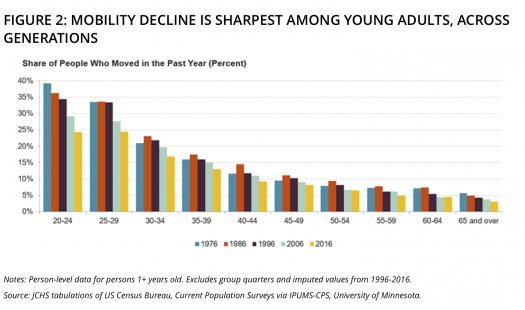A Placemaking Journal
Lessons from the Pandemic: Housing, Retail, Broadband
 This is the second in a series of conversations about what comes next in local government policies and processes. Geoff Koski is president of the Bleakly Advisory Group, providing advice to real estate professionals, governments, and non-profit organizations dealing with a wide- range of real estate and economic development-related issues. Read the first post in this series here.
This is the second in a series of conversations about what comes next in local government policies and processes. Geoff Koski is president of the Bleakly Advisory Group, providing advice to real estate professionals, governments, and non-profit organizations dealing with a wide- range of real estate and economic development-related issues. Read the first post in this series here.
Ben Brown: There’s no getting around the cloud of uncertainty that will continue to frustrate planning efforts for the next few months. But that doesn’t mean those responsible for making and implementing policies, whether we’re talking leaders in government or business, can get away with doing nothing. Doing nothing is policy by default. So acknowledging all that, what are you encouraging your clients to think about right now?
Geoff Koski: Whether we’re talking about housing or retail or office space, I think the overarching impact of the pandemic and the Great Lockdown is that they will be trend accelerators. The need for innovative affordable housing answers, retail increasingly moving online, the death of distance in the logistics field, the work-from-home shift — all of these things were real and happening at the beginning of 2020. And they’ve only become more apparent and happening faster now.
BB: “Death of distance in the logistics field”? Explain more about that.
GK: We’re growing slower as a population and moving less. We’re having fewer kids. Suburban school districts are telling us that they aren’t seeing the student-to-new-home ratio that they experienced in the past. Remote working has already had effects on intra-national migration for employment, and it seems likely the pandemic and the lockdown experience for both workers and employers will only increase reliance on technology to shrink distances.
BB: Okay, fewer moves cross-country. But what might pandemic-driven trends suggest about moves within a region?
GK: Whatever shifts occur, they will not turn back the demographics. Current trends of additional smaller households living in more mixed-use settings is not going away. But there was also a countervailing trend emerging pre-COVID that saw Millennials having kids and becoming first-time homebuyers in the suburbs. That is likely to continue as well. They can both be true at the same time.
BB: It’s not hard, though, to imagine that the fears the pandemic aroused will bend trend lines. Are cities still where the action is, even if density has made people nervous? Or will the experience push more families to the burbs where they might feel safer in single-family homes?
GK: So the question is, do more isolated living arrangements, where people might feel safe from an invisible virus and where householders don’t have to commute to work, mean that folks will find a spot in the hinterlands and cocoon? Probably yes, to an extent. Does that mean the death of urban centers? Probably no. The positive impact of agglomeration on economic development is too great and can’t be replaced entirely by Zoom meetings.
BB: So let’s talk about urban areas. The pre-pandemic trends in metro areas have had their own challenges, particularly with regard to affordability. What’s the likely impact on housing?
GK: The big question, of course, is how negatively impactful this will be to rents and sales prices. There’s a good chance at this point that pricing will drop to levels that lower the costs side of affordability gaps. But whether or not gaps close will depend on impacts on the household income side. And, of course, everything depends on the length and severity of the economic downturn. Going into the pandemic, we already knew what slowing household formations in the face of economic hardship looked like. It looked like more renters. We had been underproducing housing, especially the home types most in demand. That’s what led to the lament over the “missing middle.” Fewer new households and less migration might suggest decreasing demand in the aggregate, but we’ll likely emerge from the worst of the pandemic with even more people needing housing in those same underserved niches.
BB: And the policy response?
GK: Interventions that lead to more homes for smaller, childless households – especially in the lower income categories – will probably be more necessary than ever. We posted about this topic, applied to the Atlanta Metro, on our firm blog in mid-April.
BB: So local policy-makers are facing the same affordable housing challenges they had before the coronavirus. What are the options for them?
GK: Proactive real estate investors are out looking for distressed property now as a land banking strategy. Local governments could be doing the same, that is, finding property that would work for housing, buying it at distressed pricing, and holding it for a time when it can become affordable or mixed-income housing. The problem is that local government have other pressing issues right now. They are looking at 20%-30% reductions in their revenues and are scrambling to figure out what their budget gap will look like and how to fill it. So, even the most well-meaning local governments may not be looking at maneuvers aimed at longer-term affordable housing for a bit and therefore may not be able to execute a land-banking strategy.
BB: Any other paths to increasing the niche housing supply?
GK: I’m sure I’m not the first person to think of this, but the craft beer movement suggests a parallel with the missing middle effort. In a time of slowing or declining demand for beer produced by the big companies, savvy local entrepreneurs taught themselves how to target a niche of beer consumers most people didn’t know existed. They grew a market segment with new and interesting products. It took some loosening of laws. When that happened, the craft beer business exploded everywhere even as overall beer sales were down. The same thing could happen if local governments removed barriers to building missing middle housing. The obstacle craft beer didn’t have, of course, is NIMBYism.
BB: One of the effects of NIMBYism is a slowdown in processes that lead to permitting.
GK: Aggressive streamlining of entitlement processes can help. It was a great idea before COVID and will be after. But those types of things take time and, often, public processes that work through the concerns of NIMBYs. Right now, city councils are still figuring out how to hold public meetings and hearings without risking the virus’s spread. Permitting offices are figuring out how to move permitting online. Once these things play out, then yes, if it was a good idea to incentivize more affordable housing before COVID, it will be after.
BB: What about the commercial real estate sector where retail – and especially small, local retail – is taking a huge hit during the lockdown?
GK: I think the lockdown experience will open up thinking about “affordable retail.” The winners will be the localities that are flexible and allow for lots of choices. Just as it’s important to remove barriers to innovation in residential housing, it helps to do the same when it comes to restaurants and shops. Some communities mistakenly try to protect brick-and-mortar establishments by overly restricting pop-up retail, food trucks, and other low-overhead start-ups and facility-sharing experiments. There won’t be any local bricks-and-mortar to help without giving them flexibility to diversify revenue streams. Mobile markets, shared kitchens, performance rents, for instance. Maybe even incentives for affordable retail.
BB: Fixing all these policies and processes will be a heavy lift. Is there one particular topic you consider a particular priority?
GK: Broadband needs to be seen as a public utility. This is the biggest equity issue coming out of this. We’ve got to make sure everyone has internet access, especially in a post-pandemic period that will alter the worlds of work and education. Some school districts have used buses to provide hotspots in locations where there is not internet access for homes. It’s a great emergency use of public resources, but what happens when those buses go back to transporting kids and the world has moved even more online? Those households without internet are going to fall even farther behind in the post-COVID world. We owe it to ourselves and all our citizens to find a way to pipe the internet into everyone’s home, just like water and electricity.
BB: Another concern about the world after the lockdown: What happens to transit planning?
GK: This is a serious issue and needs much more attention. To me, the bottom line is that we must look at transit for what it is – a public good. It’s not going to pay for itself. It’s going to need to be supported with tax dollars. Again, that was true before and it will be even more so in the future. I think we’ve done a terrible job of making the case that even if you don’t ride transit, it’s a positive, and worth your tax dollars, to live in an area with robust transit. Transit agencies, like local governments, are likely going to need a bailout of some sort, whether the help comes from local taxes or the federal government. We need to be able to articulate why this investment is worth it. But I’m not optimistic we will have that breakthrough.
BB: So much seems to hinge on the resources local governments can count on from the Feds. What do we know so far about potential relief from Congress?
GK: One thing to keep an eye on is the federal government’s response to the impending financial crisis for local government. They’ve already increased funding for Community Development Block Grant programs. What will local entities do with that? Will it be transformative? Will the Feds come up with more and better ways to get money into the hands of local government? Or will they let them waive in the wind? If more and better funds for locals are coming, what shape and form will that take and what issues will they be best suited to address? Lots of questions there, but things are so fluid right now, especially with the relief and recovery funds coming — and not coming — out of Washington, it’s hard to know what will stick and what will be useful on the ground.
If PlaceShakers is our soapbox, our Facebook page is where we step down, grab a drink and enjoy a little conversation. Looking for a heads-up on the latest community-building news and perspective from around the web? Click through and “Like” us and we’ll keep you in the loop.




